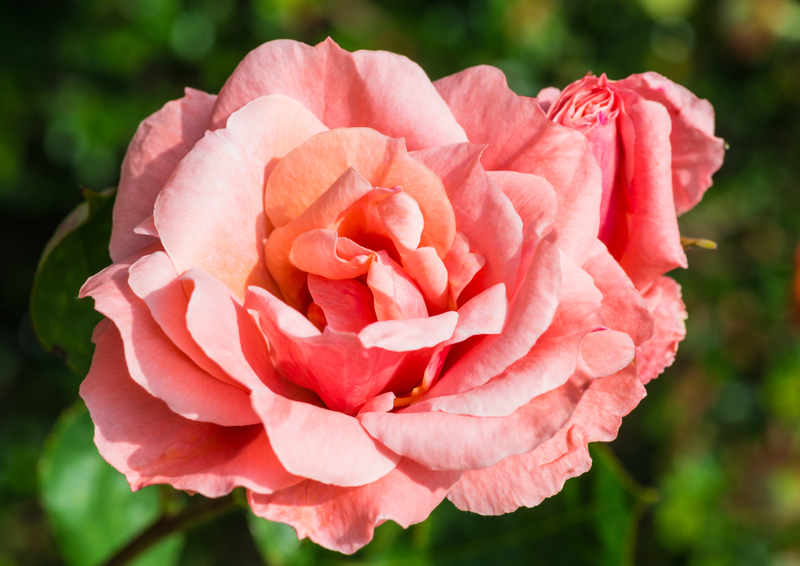Designing a Low-Wind Impact Garden for Plant Health
Posted on 27/08/2025
Designing a Low-Wind Impact Garden for Plant Health: A Comprehensive Guide
Are you struggling to maintain healthy plants due to harsh or constant winds in your area? Designing a low-wind impact garden is the answer to promoting stronger plant vitality and ensuring a lush, thriving green space. Excessive wind can cause physical damage to plants, impede growth, and dry out both soil and foliage. In this detailed guide, you will learn the principles, strategies, and benefits of creating a wind-resistant garden for optimal plant health.

Understanding the Effects of Wind on Plant Health
Wind can profoundly affect plant well-being. Before delving into garden design, it's essential to grasp how and why wind is detrimental:
- Moisture Loss: Winds rapidly evaporate water from soil and leaves, leading to drought stress.
- Physical Damage: Strong gusts can break stems, tear leaves, and uproot young plants.
- Temperature Fluctuations: Wind increases transpiration, causing leaves and soil to cool down too quickly, which stresses plants.
- Impeded Pollination: High winds can hinder pollinators and disrupt the pollination process.
- Pest Dispersion: Winds may introduce or spread airborne pests and diseases.
Designing a low-wind impact garden helps counteract these issues, supporting robust growth and reducing maintenance.
Principles of a Low-Wind Impact Garden Design
Successful low-wind garden design incorporates several foundational principles:
- Wind Assessment: Observe your garden to identify prevailing wind directions, wind strength, duration, and seasonal fluctuations.
- Layering: Use multiple layers of vegetation and structural elements to slow and diffuse wind.
- Windbreaks: Install fences, hedges, or trees to block direct wind flow.
- Microclimate Creation: Shape your space to foster sheltered areas for sensitive plants.
- Resilient Plant Choices: Select varieties naturally tolerant to wind exposure.
Step 1: Analyze the Wind Patterns in Your Garden
Start by observing which way prevailing winds blow across your landscape. Is your garden exposed to steady breezes, sudden gusts, or seasonal winds? Use the following techniques:
- Visual Indicators: Bent tree trunks, leaning plants, or eroded soil can show wind's path.
- Weather Data: Consult local weather stations for wind direction and speed information.
- Temporary Markers: Place lightweight ribbons on stakes and monitor how they move.
Mapping wind movement unveils where vulnerabilities and opportunities lie in your garden's layout.
Strategic Placement of Windbreaks & Barriers
The Science Behind Windbreaks
A windbreak is any structure or planting that reduces wind speed. Surprisingly, a solid barrier isn't always best; wind tends to whip over or around solid objects creating turbulence and eddy currents. The most effective windbreaks are semi-permeable, letting some air through to diffuse, slow, and redirect wind instead of completely blocking it. This sustains a calmer zone on the leeward side, ideal for delicate plants.
Types of Windbreaks in Garden Design
-
Living Windbreaks:
- Trees: Evergreens (e.g., junipers, cypresses, or hollies) offer year-round protection. Deciduous options (e.g., hornbeam, beech) provide leafy cover in summer. Plant in staggered rows for max coverage.
- Hedges: Dense shrubs such as privet, boxwood, or pittosporum are excellent for low-level wind protection along borders.
-
Structural Windbreaks:
- Fences: Lattice or slatted fences allow partial airflow and reduce wind speeds more effectively than solid panels.
- Walls: Brick or stone walls give robust protection, especially when designed with gaps or height variation.
- Temporary/Seasonal Barriers: Shade cloths, garden netting, or trellises covered with climbing plants.
TIP: The height of a windbreak determines its protected zone -- typically, the downwind shelter area extends as far as 10-15 times the height of the barrier, gradually diminishing with distance.
Selecting the Right Plants for a Wind-Resilient Garden
Characteristics of Wind-Resistant Plants
- Flexible stems and branches that can bend without snapping.
- Small, tough, or waxy leaves that resist tearing and excessive moisture loss.
- Deep or widespread root systems to anchor them firmly.
- Natural growth forms like compact, low-mounding, or ground-hugging shapes.
Best Plant Types for Wind-Prone Gardens
Consider these low-wind impact garden plant selections for diverse roles:
- Windbreak Layer: Pines, junipers, hawthorns, holly, pittosporum, yew, oleander.
- Shrub Layer: Lavender, rosemary, escallonia, hebes, sage, photinia, cotoneaster.
- Ground Cover: Thyme, creeping juniper, artemisia, vinca, ice plant, ajuga.
- Ornamentals: Ornamental grasses (fescues, miscanthus), daylilies, sedum, alliums.
- Edibles: Kale, chives, leeks, Swiss chard (robust and can withstand moderate wind).
Combine multiple resilient species to create not only wind shelter but also a habitat supporting biodiversity and visual interest.
Garden Layout Techniques for Reducing Wind Impact
Maximize Shelter with Strategic Zoning
Arrange your wind-protected garden with thoughtful placement of plants and structures:
- Zone 1: Upwind edge -- plant high, dense windbreaks here.
- Zone 2: Middle zone -- use medium-height shrubs and semi-permeable fencing.
- Zone 3: Core or leeward -- allocate for the most vulnerable or prized plants (flowers, herbs, vegetables).
Layering and Graduated Planting
Stagger plant heights from tallest windbreaks to low ground covers for a gentle wind gradient. This gradation:
- Reduces wind acceleration and turbulence.
- Prevents exhaustion and breakage of any one protective layer.
- Creates small microclimates ideal for sensitive plantings.
Garden Shape and Features
- Curved rather than straight garden borders disrupt wind flow--sharp angles funnel wind, while softened shapes slow it down.
- Berms and mounds can deflect and filter winds when combined judiciously with plantings.
- Water features, walls, and sitting areas should be situated in sheltered spots to maximize comfort and calm for humans and plants alike.
Implement these layout strategies for an attractive, cohesive, and low-wind impact landscape design.
Soil and Water Management in Windy Gardens
Soil Conditioning for Wind Exposure
- Add organic matter like compost and mulch to improve soil water retention and protect delicate surface roots.
- Use ground covers or low-growing plants to shield soil from direct wind, reducing evaporation and erosion.
- Avoid leaving bare soil exposed as wind quickly dries and degrades it.
Efficient Watering Practices
- Drip irrigation or soaker hoses deliver water directly to roots, minimizing loss from wind evaporation.
- Water early morning or late evening for best absorption and minimal evaporation.
- Mulch thickly around all plant bases to retain moisture and stabilize temperatures.
Why is this crucial? Wind accelerates evaporation. Proper soil and watering solutions offer sustained hydration and resilience in even the breeziest gardens.
Additional Ideas for Elevating Protection and Garden Health
Temporary and Moveable Solutions
- Portable screens or trellises can be repositioned to shield delicate plants as needed.
- Cloche covers, cold frames, or garden domes help establish a microclimate for seedlings and transplants.
Maximize Microclimate Benefits
- Cluster pots and planters together for mutual protection.
- Use existing sheds or outbuildings for additional wind shadow.
- Group plants in favorable pockets (behind walls or near dense hedges) for extra shelter.
Year-Round Maintenance and Adaptation
- Regularly trim and shape windbreak plants to maintain density and effectiveness.
- Replace damaged barriers or structural protections before the windy season starts.
- Adapt garden layouts seasonally if you notice significant wind shifts throughout the year.
Real-Life Examples of Low-Wind Impact Garden Designs
- Coastal Gardens: Use hardy salt-tolerant plants, like sea buckthorn or tamarisk, and establish multi-row windbreaks of mixed shrubs and grasses.
- Urban Rooftop Gardens: Install mesh or lattice wind screens and use raised beds with densely planted edges.
- Open Rural Gardens: Combine earth berms with lines of conifers and native shrubs to establish wind-protected 'rooms.'
Each approach is uniquely tailored, but all revolve around the same core concept: breaking, diffusing, and redirecting wind forces to encourage vibrant, healthy plant growth.

Why Choose a Low-Wind Impact Garden?
Why invest in a garden designed for wind protection? The answers are clear:
- Boosts plant vitality: Prevents damage and accelerates growth by maintaining optimal conditions.
- Reduces watering needs: Protects soil moisture and lessens dependency on irrigation.
- Increases biodiversity: Fosters new microhabitats and attracts wildlife.
- Makes outdoor spaces more enjoyable: Calmer, less abrasive spaces are better for relaxing and socializing.
- Improves garden efficiency: Cuts maintenance time and costs due to fewer wind-related issues.
Conclusion: Achieving a Healthy, Wind-Resilient Garden
Designing a low-wind impact garden isn't just about battling the forces of nature; it's about understanding your environment and using a blend of thoughtful planning, strategic planting, and clever landscaping. By mastering windbreaks, selecting resilient plants, managing water and soil wisely, and creating sheltered microclimates, you can nurture a green oasis that visibly thrives despite the breeze.
Embrace these design principles and transform your garden into a wind-protected haven for plant health and beauty all year round.

